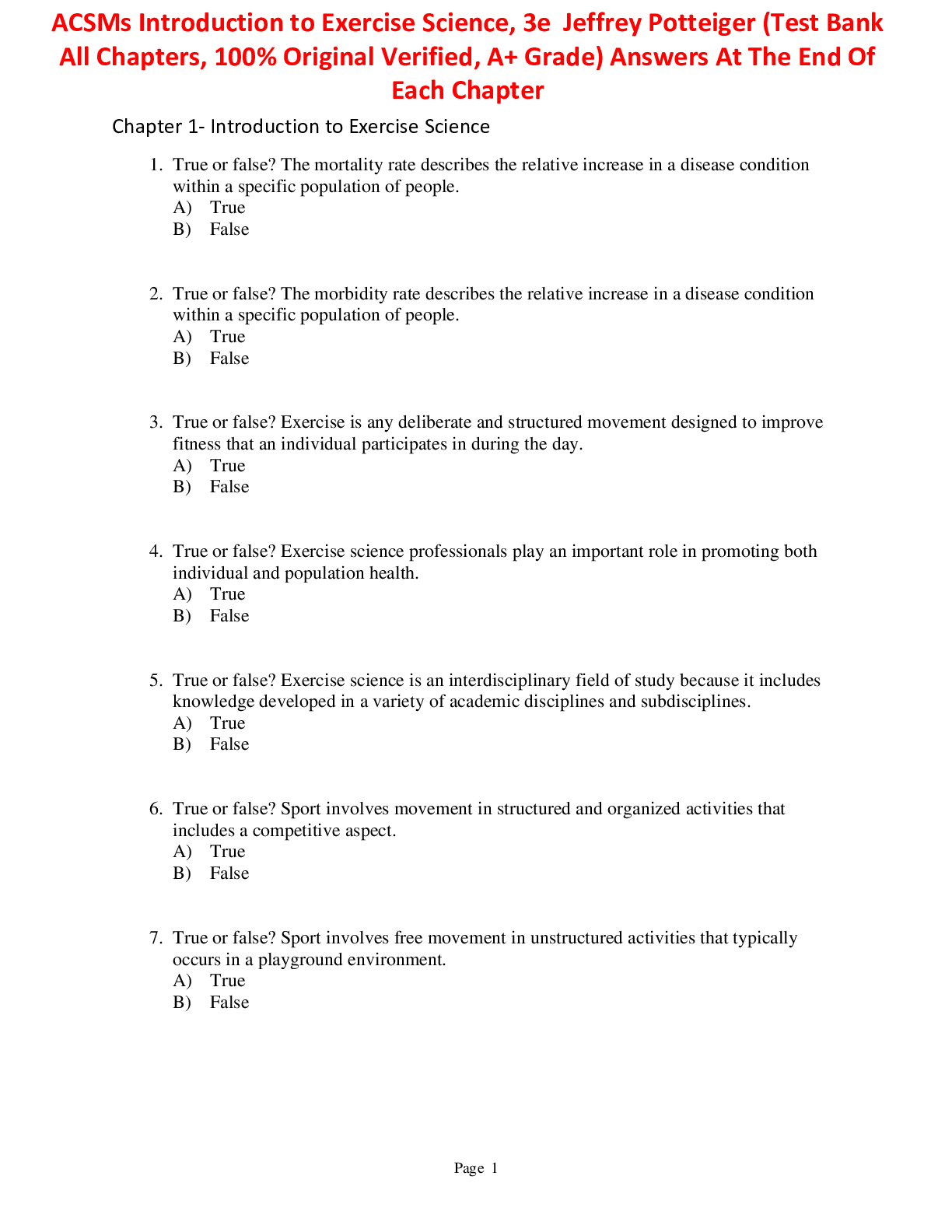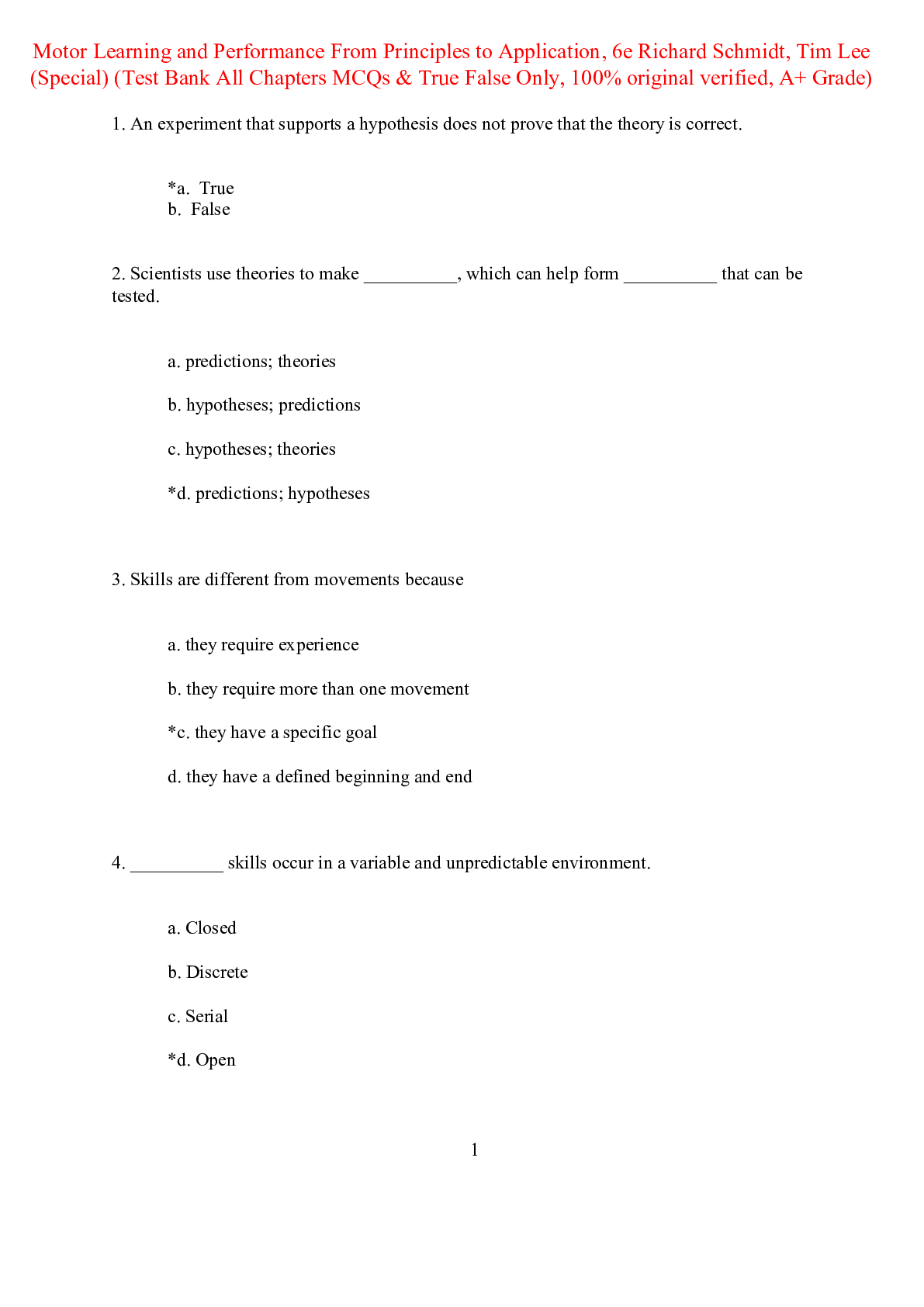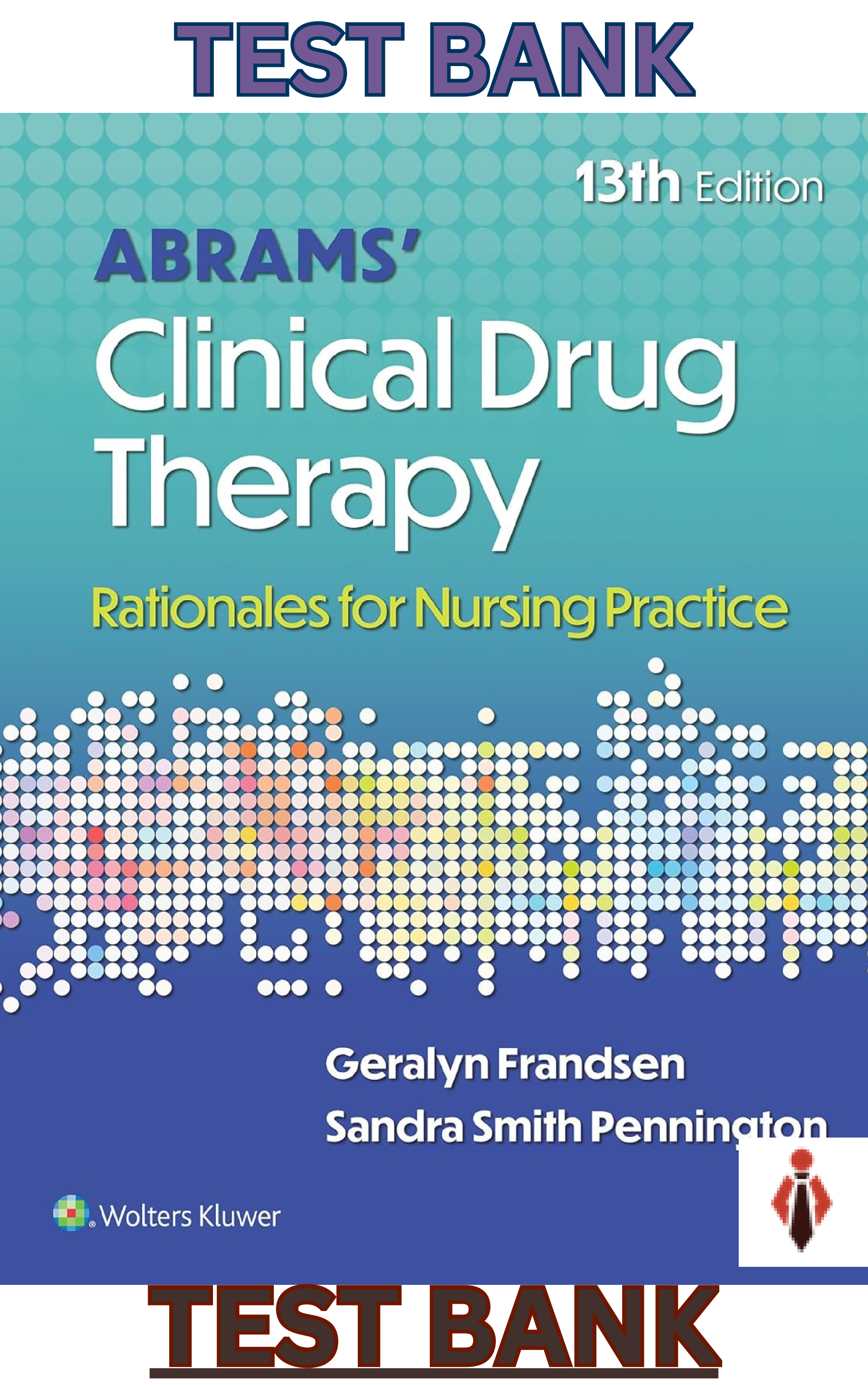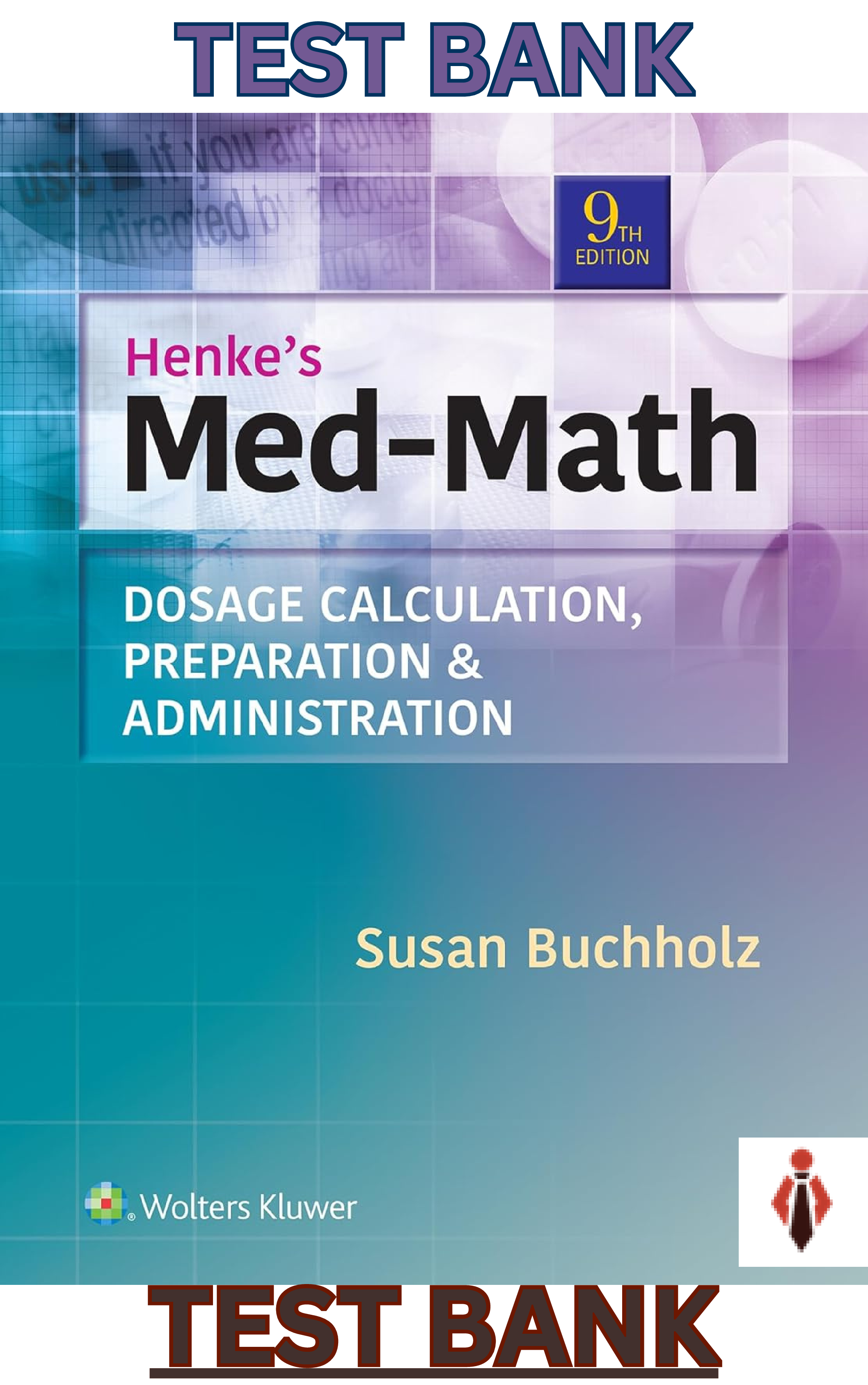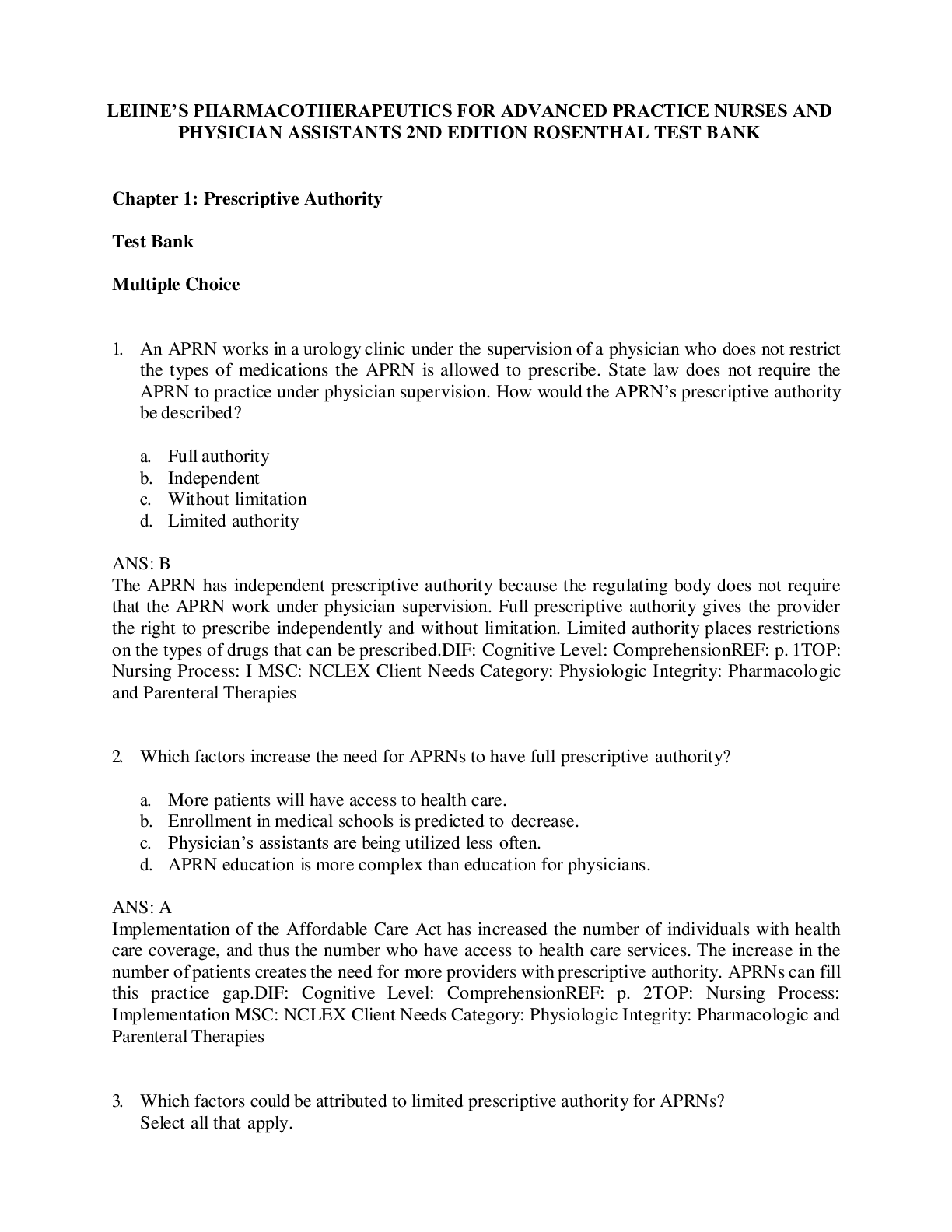Health Care > TEST BANK > TEST BANK FOR A Manual of Laboratory and Diagnostic Tests 7th edition Frances T Fischbach (All)
TEST BANK FOR A Manual of Laboratory and Diagnostic Tests 7th edition Frances T Fischbach
Document Content and Description Below
Chart 1.1 Grading Guidelines for Scientific Evidence A. Clear evidence from all appropriately conducted trials A. Measure plasma glucose through an accredited lab to diagnose or screen for diabete... s B. Supportive evidence from well-conducted studies or registries B. Draw fasting blood plasma specimens for glucose analysis C. No published evidence; or only case, observational, or historical evidence C. Self-monitoring of blood glucose may help to achieve better control D. Expert consensus or clinical experience or Internet polls D. Measure ketones in urine or blood to monitor and diagnose diabetic ketoacidosis (DKA) (in home or clinic) As an integral part of their practice, clinicians have long supported patients and their significant others in meeting the demands and challenges incumbent in the simplest to the most complex diagnostic testing. This testing begins before birth and frequently continues after death. The clinician who provides diagnostic services must have basic requisite knowledge to plan patient care and an understanding of psychoneuroimmunology (effects of stress on health status), must make careful judgments, and must gather vital information about the patient and the testing process, to diagnose appropriately within the parameters of the clinician's professional standards ( Table 1.2; Chart 1.2). Table 1.2 Examples of Inappropriate Tests and Replacement Tests Inappropriate Replacement Prostatic acid phosphatase PSA or free PSA Ammonia AST, GGT Crossmatch (needed if blood is actually to be given) Type and screen Calcium Ionized calcium CBC Hemogram HCV antibody HCV RNA by PCR Iron Ferritin Lupus cell ANA Creatinine Urea CRP ESR PSA, prostate-specific antigen; AST, aspartate transaminase; GGT, gamma-glutamyltransferase; CBC, complete blood count; HCV, hepatitis C virus; PCP, polymerase chain reaction; ANA, antinuclear antibody; CRP, C-reactive protein; ESR, erythrocyte sedimentation rate. Chart 1.2 Basics of Informed Care Manage testing environment using collaborative approach Communicate effectively and clearly Prepare the patient properly Follow standards Consider culture, gender, and age diversity Measure and evaluate outcomes; modify treatment as necessary Manage effective diagnostic services using team approach Interpret, treat, monitor, and counsel about abnormal test outcomes Maintain proper test records The diagnostic testing model incorporates three phases: pretest, intratest, and posttest ( Fig. 1.1). The clinical team actively interacts with the patient and his or her significant others throughout each phase. The following components are included with each laboratory or diagnostic test in this text: FIGURE 1.1 Model* for the role** of the clinical team in diagnostic care*** and services.**** Pretest Interventions: Intratest Interventions: Posttest Interventions: 1. Test background information 2. Normal (reference values) 3. Explanation of test 4. Indications for testing 1. Actual description of procedures 2. Specimen collection and transport 3. Clinical implications of abnormal results 4. Interfering factors 1. Patient aftercare 2. Clinical, education, and procedure alerts 3. Special cautions 4. Interpretation of test results Each phase of testing requires that a specific set of guidelines and standards be followed for accurate, optimal test results. Patient care standards and standards of professional practice are key points in developing a collaborative approach to patient care during diagnostic evaluation. Standards of care provide clinical guidelines and set minimum requirements for professional practice and patient care. They protect the public against less-than-quality care ( Table 1.3). Table 1.3 Standards for Diagnostic Evaluation Source of Standards for Diagnostic Service Standards for Diagnostic Testing Examples of Applied Standards for Diagnostic Testing Professional practice parameters of American Nurses Association (ANA), American Medical Association (AMA), American Society of Clinical Pathologists (ASCP), American College of Radiology, Centers for Disease Control and Prevention (CDC), JCAHO health care practice requirements Use a model as a framework for choosing the proper test or procedure and in the interpretation of test results. Use laboratory and diagnostic procedures for screening, differential diagnoses, follow-up, and case management. Test strategies include single tests or combinations/ panels of tests. Panels can be performed in parallel, series, or both. The guidelines of the major agencies, such as American Heart Association, Cancer Society, and American Diabetes Association Order the correct test, appropriately collect and transport specimens. Properly perform tests in an accredited laboratory or diagnostic facility. Accurately report test results. Communicate and interpret test findings. Treat or monitor the disease and the course of therapy. Provide diagnosis as well as prognosis. Patients receive diagnostic services based on a documented assessment of need for diagnostic evaluation. Patients have the right to necessary information, benefits, or rights, to enable them to make choices and decisions that reflect their need or wish for diagnostic care. Individual agency and institution policies and procedures and quality-control criteria for specimen collection, procedure statement for monitoring the patient after an invasive procedure, and policy for universal witnessed consent situations. Statements on quality improvement standards. Use standards of professional practice and standards of patient care. Use policy for obtaining informed consent/witnessed consent. Use policies for unusual situations. Observe standard precautions (formerly known as universal precautions). Use latex allergy protocols and required methodology of specimen collection. Use standards and statements for monitoring patients who receive conscious sedation and analgesia. Vital signs are monitored and recorded at specific times before and after the procedure. Patients are monitored for bleeding and respiratory or neurovascular changes. Record data regarding outcomes when defined care criteria are implemented and practiced. Protocols to obtain appropriate consents are employed, and deviations from basic consent policies are documented and reported to the proper individual. The clinician wears protective eyewear and gloves when handling all body fluids and employs proper handwashing before and after handling specimens and between patient contacts. Labeled biohazard bags are used for specimen transport. Vital signs are monitored and recorded at specific times before and after the procedure. Patients are monitored for bleeding and respiratory or neurovascular changes. Record data regarding outcomes when defined care criteria are implemented and practiced. Protocols to obtain appropriate consents are employed, and deviations from basic consent policies are documented and reported to the proper individual. State and federal government communicable disease reporting regulations; Centers for Disease Control and Prevention (CDC), U.S. Department of Health and Human Services, Agency for Health Care Policy and Research (AHCPR), and Clinical Laboratory Improvement Act (CLIA) Clinical laboratory personnel and other health care providers follow regulations to control the spread of communicable diseases by reporting certain disease conditions, outbreaks, and unusual manifestations, morbidity, and mortality data. Findings from research studies provide health care policy makers with evidence-based guidelines for appropriate selection of tests and procedures. The clinician reports laboratory evidence of certain disease classes (eg, sexually transmitted diseases, diphtheria, Lyme disease, symptomatic HIV infection; see list of reportable diseases). Personnel with hepatitis A may not handle food or care for patients, young children, or the elderly for a specific period of time. Federal government regulates shipment of diagnostic specimens. MR and CT are used to evaluate persistent low back pain according to AHCPR guidelines. U.S. Department of Transportation Alcohol testing is done in emergency rooms in special situations (eg, following a motor vehicle accident, homicide, or suicide, or an unconscious individual). Properly trained personnel perform blood, saliva, and breath alcohol testing and use required kits as referenced by federal law. Occupational Safety and Health Administration (OSHA) Workplace testing The clinician is properly trained, under mandated guidelines, to administer employee medical surveillance and respirator qualification and fit testing. JCAHO, Joint Commission on Accreditation of Healthcare Organizations; HIV, human immunodeficiency virus; MR, magnetic resonance; CT, computed tomography. If test results are inconclusive or negative and no definitive medical diagnosis can be established, other tests and procedures may be ordered. Thus, testing can become an involved and lengthy process (see Fig. 1.1). Understanding the basics of safe, effective, and informed care is important. These basics include assessing risk factors and modifying care accordingly, using a collaborative approach, following proper guidelines for procedures and specimen collection, and delivering appropriate care throughout the process. Providing reassurance and support to the patient and his or her significant others, intervening appropriately, and clearly documenting patient teaching, observations, and outcomes during the entire process are important (see Fig. 1.1). A risk assessment before testing identifies risk-prone patients and helps to prevent complications. The following factors increase a patient's risk for complications and may affect test outcomes: 1. Age > 70 years 2. History of falls 3. History of serious chronic illnesses 4. History of allergies (eg, latex, contrast iodine, radiopharmaceuticals, and other medications) 5. Infection or increased risk for infection (eg, human immunodeficiency virus [HIV], organ transplantation, chemotherapy, radiation therapy) 6. Aggressive or antisocial behavior 7. Seizure disorders 8. Uncontrolled pain 9. Gastric motility dysfunction 10. Use of assistive devices for activities of daily living (ADLs) 11. Unsteady gait, balance problems 12. Neuromuscular conditions 13. Weakness, fatigability 14. Paresthesias 15. Impaired judgment or illogical thinking 16. Severe visual problems 17. Hearing impairment 18. Use of diuretics, sedatives, analgesics, or other prescription or over-the-counter (OTC) drugs 19. Alcohol or illegal drug use or addiction The environments in which diagnostic services are provided, the degree of cultural diversity present in the community, and the physical, emotional, social, and spiritual state of the patient all influence the patient's response to the procedure. Including the patient's significant others is a vital component of the entire process and must not be taken lightly or casually dismissed. Testing environments vary. Certain tests (eg, cholesterol screening, blood glucose, electrocardiogram [ECG], lipid profiles, tuberculosis [TB] skin tests) can be done “in the field,” meaning that the service is brought to the patient's environment. Other tests (eg, x-rays using contrast media and those that require special patient preparation, invasive procedures, nuclear medicine procedures, hormone levels, and 24-hour urine testing panels) must be done in a physician's office, clinic, or hospital setting. Magnetic resonance (MR) imaging and ultrasound procedures (eg, echocardiograms) are commonly performed in freestanding or specialty diagnostic centers. Complex tests such as endoscopic retrograde cholangiopancreatography (ERCP), cardiac catheterization, or bronchoscopy may require hospital admission or at least outpatient status. As testing equipment becomes more technologically sophisticated and risks associated with testing are reduced, the environment in which diagnostic procedures take place will also shift. Insurance reimbursement for testing also influences trends. Managed care and case management, together with collaboration among the diverse health care disciplines and the patient, are key factors in determining how and to what degree optimal diagnostic services are used. Clear, timely, accurate communication among all patients and professionals is key to minimizing problems and frustrations. As societies become more culturally blended, the need to appreciate and work within the realm of cultural diversity becomes imperative. Interacting with patients and directing them through diagnostic testing can present certain challenges if one is not familiar and sensitive to the health care belief system of the patient and his or her significant others. Something as basic as attempting to communicate in the face of language differences may necessitate arrangements for a relative or translator to be present during all phases of the process. Special attention and communication skills are necessary for these situations as well as when caring for children and for comatose, confused, or frail patients. Consideration of these issues will significantly influence compliance, outcomes, and positive responses to the procedure. To be most effective, professional care providers must be open to a holistic perspective and attitude that affects their care giving, communication, and patient-empowering behaviors. Clinicians who understand the patient's basic needs and expectations and strive to accommodate those as much as possible are truly acting as patient advocates. Preparing patients for diagnostic or therapeutic procedures, collecting specimens, carrying out and assisting with procedures, and providing follow-up care have long been requisite activities of professional practice. This care may continue even after the patient's death. Diagnostic postmortem services include death reporting, possible postmortem investigations, and sensitive communication with grieving families and significant others regarding autopsies, unexplained death, other postmortem testing, and organ donation (see Chap. 16). Professionals need to work as a team to meet diverse patient needs, to facilitate certain decisions, to develop comprehensive plans of care, and to help patients modify their daily activities to meet test requirements in all three phases. It is a given that institutional protocols are followed. PRETEST PHASE: ELEMENTS OF SAFE, EFFECTIVE, INFORMED CARE The emphasis of pretest care is on appropriate test selection, obtaining proper consent, proper patient preparation, individualized patient education, emotional support, and effective communication. These interventions are key to achieving the desired outcomes and preventing misunderstandings and errors. Basic Knowledge and Necessary Skills Know the test terminology, purpose, process, procedure, and normal test reference values or results. The names of diseases are a convenient way of briefly stating the endpoint of a diagnostic process that begins with assessment of symptoms and signs and ends with knowledge of causation and detection of underlying disorders of structure and function. The clinical value of a test is related to its sensitivity, its specificity, and the incidence of the disease in the population tested. Sensitivity and specificity do not change with different populations of ill and healthy patients. The predictive value of the same test can vary significantly with age, gender, and geographic location. Specificity refers to the ability of a test to identify correctly those individuals who do not have the disease. The division formula for specificity is as follows: Sensitivity refers to the ability of a test to correctly identify those individuals who truly have the disease. The division formula for sensitivity is as follows: Incidence refers to the prevalence of a disease in a population or community. The predictive value of the same test can be very different when applied to people of differing ages, genders, geographic locations, and cultures. Predicted Values refer to the ability of a screening test result to correctly identify the disease state. True-positive results correctly identify individuals who actually have the disease, and true-negative results correctly identify individuals who do not actually have the disease. Positive predictive value equals the percentage of positive tests with true-positive results (ie, the individual does have the disease). Negative predictive value refers to the percentage of negative tests with true-negative results (ie, the individual does not have the disease). See Table 1.4 for an example that demonstrates the specificity, sensitivity, and predictive values for a new screening test to identify the cystic fibrosis gene. Table 1.4 Sample Test Results Test Result Have Gene for Cystic Fibrosis Do Not Have Gene for Cystic Fibrosis Total Positive 62 5 67 Negative 15 341 356 TOTAL 77 346 423 Thus, this new screening test will give a false-negative result about 20% of the time (eg, the person does have the cystic fibrosis gene but his or her test results are negative). Thus, there is about an 8% change that the person will test positive for the cystic fibrosis gene but does not have it. Thus, there is about a 5% chance that the person will test negative for the cystic fibrosis gene but actually does have it. Look at both current and previous test results and review the most recent laboratory data first, then work sequentially backward to evaluate trends or changes from previous data. The patient's plan of care may need to be modified because of test results and changes in medical management. Testing Environments Diagnostic testing occurs in many different environments. Many test sites have shifted into community settings and away from hospitals and clinics. Point-of-Care Testing refers to tests done in the primary care setting. In acute care settings (eg, critical care units, ambulances), state-of-the-art testing can produce rapid reporting of test results. Testing in the home care environment requires skill in procedures such as drawing blood samples, collecting samples from retention catheters, proper specimen labeling, documentation, specimen handling, and specimen transporting. Moreover, teaching the patient and his or her significant others how to collect specimens is an important part of the process. In occupational health environments, testing may be done to reduce or prevent known workplace hazards (eg, exposure to lead) and to monitor identified health problems. This can include preemployment baseline screening, periodic monitoring of exposure to potentially hazardous workplace substances, and drug screening. Skill in drawing blood samples, performing breathing tests, monitoring chain of custody (see page 226 in Chap. 3), and obtaining properly signed and witnessed consent forms for drug testing is required. More pretest, posttest, and follow-up testing occurs in nursing homes because patients are more frequently taken or transferred to hospitals for more complex procedures (eg, computed tomography [CT] scans, endoscopies), whereas this is not the case with routine testing. Increasing numbers of “full code” (ie, resuscitation) orders leads to greater numbers and varieties of tests. Additionally, confused, combative, or uncooperative behaviors are seen more frequently in these settings. An attitude adopted by nursing home patients of “not wanting to be bothered” or engaging in outright refusal to undergo prescribed tests can make testing difficult. Consequently, understanding patient behaviors and using appropriate communication strategies and interventions for this population are necessary skills for practicing in this arena. For those who practice in the realm of public health, diagnostic test responsibilities focus on wellness screenings, preventive services, disease control, counseling, and treatment of individuals with problems. Case finding frequently occurs at health fairs, outreach centers, homeless shelters, neighborhood nurse offices, mobile health vans, and church settings. Responsibilities vary according to setting and may include providing test information, procuring specimens, and providing referrals to appropriate caregivers. These responsibilities may even extend to transporting and preparing specimens for analysis or actually performing specimen analysis (eg, stool tests for occult blood, TB skin testing, and procuring blood or saliva samples for HIV/acquired immunodeficiency syndrome [AIDS] testing). History and Assessment Obtain a relevant, current health history; perform a physical assessment if indicated. Identify conditions that could influence the actual testing process or test outcomes (eg, pregnancy, diabetes, cultural diversity, language barrier, physical impairment, altered mental state). 1. Perform a risk assessment for potential injury or noncompliance. 2. Identify contraindications to testing such as allergies (eg, iodine, latex, medications, contrast media). Records of previous diagnostic procedures may provide clues. 3. Assess for coping styles and knowledge or teaching needs. 4. Assess fears and phobias (eg, claustrophobia, “panic attacks,” fear of needles and blood). Ascertain what strategies the patient uses to deal with these reactions and try to accommodate these. 5. Observe standard/universal precautions with every patient (see Appendix A). A patient may choose not to disclose drug or alcohol use or HIV and hepatitis risks. 6. Document relevant data. Address patient concerns and questions. This information adds to the database for collaborative problem-solving activities among the medical, laboratory/ diagnostic, and nursing disciplines. Reimbursement for Diagnostic Services Differences in both diagnostic care services and reimbursement may vary between private and government insurance. Nonetheless, quality of care should not be compromised in favor of cost reduction. Advocate for patients regarding insurance coverage for diagnostic services. Inform the patient and his or her family or significant others that it may be necessary to check with their insurance company before laboratory and diagnostic testing to make certain that costs are covered. Many insurance companies employ case managers as gatekeepers for monitoring costs, diagnostic tests ordered, and other care. As a result, the insurance company or third-party payer may reimburse only for certain tests or procedures or may not cover tests considered by them to be preventive care. So that reimbursement completely covers diagnostic services provided, be sure to include proper documentation and proper Common Practice Terminology (CPT) codes. Note date laboratory service is performed and date specimen is collected (must use). Based on 1999 data, Chart 1.3 lists laboratory tests that are covered by most insurance carriers, both private and government. Chart 1.3 Tests Covered by Most Insurance Carriers Alpha-fetoprotein Blood counts Blood glucose testing Carcinoembryonic antigen Collagen crosslinks, any method (urine osteoporosis) Digoxin therapeutic drug assay Fecal occult blood Gamma-glutamyltransferase Glycated hemoglobin/glycated protein Hepatitis panel HIV testing (diagnosis) HIV testing (prognosis including monitoring) Human chorionic gonadotropin Lipids Partial thromboplastin time Prostate-specific antigen Prothrombin time Serum iron studies Thyroid testing Tumor antigen by immunoassay—CA125 Tumor antigen by immunoassay—CA15-3/CA27 Tumor antigen by immunoassay—CA19-9 Urine culture Methodology of Testing Follow testing procedures accurately. Verify orders and document them with complete, accurate, and legible information. Document all drugs the patient is taking because these may influence test outcomes (see Appendix J). 1. Ensure that specimens are correctly obtained, preserved, handled, labeled, and delivered to the appropriate department. For example, it is not generally acceptable to draw blood samples when an intravenous line is infusing proximal to the intended puncture site. 2. Observe precautions for patients in isolation. Use standard/universal precautions. 3. As much as possible, coordinate patient activities with testing schedules to avoid conflicts with meal times and administration of medications, treatments, or other diagnostic tests and travel time. a. Maintain NPO (ie, nothing by mouth) status when necessary. b. Administer the proper medications in a timely manner. Schedule tests requiring contrast substances in the proper sequence so as not to invalidate succeeding tests. Interfering Factors Minimize test outcome deviations by following proper test protocols. Make certain the patient and his or her significant others know what is expected of them. Written instructions are very helpful. Reasons for deviations may include the following: 1. Incorrect specimen collection, handling, storage, or labeling 2. Wrong preservative or lack of preservative 3. Delayed specimen delivery 4. Incorrect or incomplete patient preparation 5. Hemolyzed blood samples 6. Incomplete sample collection, especially of timed samples 7. Old or deteriorating specimens Patient factors that can alter test results may include the following: 1. Incorrect pretest diet 2. Current drug therapy 3. Type of illness 4. Dehydration 5. Position or activity at time of specimen collection 6. Postprandial status (ie, time patient last ate) 7. Time of day 8. Pregnancy 9. Level of patient knowledge and understanding of testing process 10. Stress 11. Nonadherence or noncompliance with instructions and pretest preparation 12. Undisclosed drug or alcohol use 13. Age and gender Avoiding Errors To avoid costly mistakes, know what equipment and supplies are needed and how the test is performed. Communication errors account for more incorrect results than do technical errors. Properly identify and label every specimen as soon as it is obtained. Determine the type of sample needed and the collection method to be used. Is the test invasive or noninvasive? Are contrast media injected or swallowed? Is there a need to fast? Are fluids restricted or forced? Are medications administered or withheld? What is the approximate length of the procedure? Are consent forms and conscious sedation, oxygen, analgesia, or anesthesia required? Report test results as soon as possible. “Critical” or “panic” values must be reported to the proper persons immediately (STAT). Instruct patients and their significant others regarding their responsibilities. Accurately outline the steps of the testing process and any restrictions that may apply. Conscientious, clear, timely communication among health care departments can reduce errors and inconvenience to both staff and patients. Proper Preparation Prepare the patient correctly. This preparation begins at the time of scheduling. 1. Provide information about testing site and give directions for locating the facility; allow time to enter the facility and find the specific testing laboratory. If a copy of the written test order was given to the patient to bring to the laboratory, interpret the test order. For example, an order for a renal sonogram means that an ultrasound of the kidney will be done to “rule out” (RO) evidence or presence of abnormality or suspected problem. The terms “ultrasound” and “sonogram” are used interchangeably. 2. Plan to be at the department 15 minutes before testing if the test is scheduled for a specific time. Review all pretest instructions and be certain they are explained clearly (eg, “fasting” directions for test, tell patient what fasting actually means). 3. Be aware of special needs of those with conditions such as physical limitations or disabilities, ostomies, or diabetes; children; elderly patients; and culturally diverse patients. 4. Give simple, accurate, precise instructions according to the patient's level of understanding. For example, the patient needs to know when and what to eat and drink or how long to fast. 5. Encourage dialogue about fears and apprehensions. “Walking” a patient through the procedure using imagery and relaxation techniques may help them to cope with anxieties. Never underestimate the value of a caring presence. 6. Assess for the patient's ability to read and understand instructions. Poor eyesight or hearing difficulties may impair understanding and compliance. Speak slowly and clearly. Do not bombard the patient with information. Instruct the patient to use assistive devices such as eyeglasses and hearing aids if necessary. Clear, written instructions can reinforce verbal instructions and should be used whenever possible. In some cases, a translator or “signer,” or legal representative may be necessary. 7. Assess for language and cultural barriers. Patients behave according to personal values, perceptions, beliefs, traditions, and cultural and ethnic influences. Take these into consideration and value the patient's uniqueness to the highest degree possible. 8. Document accurately in all testing phases. Patient Education Educate the patient and family regarding the testing process and what will be expected of them. Record the date, time, type of teaching, information given, and to whom the information was given. 1. Giving sensory and objective information that relates to what the patient will likely physically feel and the equipment that will be used is important so that patients can “see” a realistic representation of what will occur. Avoid technical and medical jargon and adapt information to the patient's level of understanding. Slang terms may be necessary to get a point across. 2. Encourage questions and verbalization of feelings, fears, and concerns. Do not dismiss, minimize, or invalidate the patient's anxiety through trivial remarks such as “Don't worry.” Develop “listening ears and eyes” skills. Be aware of nonverbal signals (ie, body language) because these frequently provide a more accurate picture of what the patient really feels than what he or she says. Above all, be nonjudgmental. 3. Emphasize that there is usually a waiting period (ie, “turn-around time”) before test results are relayed back to the clinicians and nursing unit. The patient may have to wait several days for results. Offer listening, presence, and support during this time of great concern and anxiety. 4. Record test result information. Include the patient's response. Just because something is taught does not necessarily mean that it is learned or accepted. The possibility that a diagnosis will require a patient to make significant lifestyle changes (eg, diabetes) requires intense support, understanding, education, and motivation. Document specific names of audiovisual and reading materials to be used for audit, reimbursement, and accreditation purposes. Testing Protocols Develop consistent protocols for teaching and testing that encompass comprehensive pretest, intratest, and posttest care modalities. Prepare patients for those aspects of the procedure experienced by the majority of patients. Clinicians can collaborate to collect data and to develop a list of common patient experiences, responses, and reactions. Patient Independence Allow the patient to maintain as much control as possible during the diagnostic phases to reduce stress and anxiety. Include the patient and his or her significant others in decision making. Because of factors such as anxiety, language barriers, and physical or emotional impairments, the patient may not fully understand and assimilate instructions and explanations. To validate the patient's understanding of what is presented, ask the patient to repeat instructions given to evaluate assimilation and understanding of presented information. Include and reinforce information about the diagnostic plan, the procedure, time frames, and the patient's role in the testing process. Test Results Know normal or reference values. 1. Normal ranges can vary to some degree from laboratory to laboratory. Frequently, this is because of the particular type of equipment used. Theoretically, “normal” can refer to the ideal health state, to average reference values, or to types of statistical distribution. Normal values are those that fall within 2 standard deviations (ie, random variation) of the mean value for the normal population. 2. The reported reference range for a test can vary according to the laboratory used, the method employed, the population tested, and methods of specimen collection and preservation. 3. The majority of normal blood test values are determined by measuring “fasting” specimens. 4. Be aware of specific influences on test results. For example, patient posture is important when plasma volume is measured because this value is 12% to 15% greater in a person who has been supine for several hours. Changing from a supine to a standing position can alter values as follows: increased hemoglobin (Hb), red blood cell (RBC) count, hematocrit (Hct), calcium (Ca), potassium (K), phosphorus (P), aspartate aminotransferase (AST), phosphatases, total protein, albumin, cholesterol, and triglycerides. Going from an upright to a supine position results in increased hematocrit, calcium, total protein, and cholesterol. A tourniquet applied for > 1 minute produces laboratory value increases in protein (5%), iron (6.7%), AST (9.3%), and cholesterol (5%) and decreases in K + (6%) and creatinine (2%–3%). Laboratories must specify their own normal ranges. Many factors affect laboratory test values and influence ranges. Thus, values may be normal under one set of prevailing conditions but may exhibit different limits in other circumstances. Age, gender, race, environment, posture, diurnal and other cyclic variations, foods, beverages, fasting or postprandial state, drugs, and exercise can affect derived values. Interpretation of laboratory results must always be in the context of the patient's state of being. Circumstances such as hydration, nutrition, fasting state, mental status, or compliance with test protocols are only a few of the situations that can influence test outcomes. Laboratory Reports Scientific publications and many professional organizations are changing clinical laboratory data values from conventional units to Systéme International (SI) units. Currently, many data are reported in both ways. The SI system uses seven dimensionally independent units of measurement to provide logical and consistent measurements. For example, SI concentrations are written as amount per volume (moles or millimoles per liter) rather than as mass per volume (grams, milligrams, or milliequivalents per deciliter, 100 milliliters, or liter). Numerical values may differ between systems or may be the same. For example, chloride is the same in both systems: 95 to 105 mEq/L (conventional) and 95 to 105 mmol/L (SI) (see Appe [Show More]
Last updated: 1 year ago
Preview 1 out of 755 pages
.png)
Reviews( 0 )
Document information
Connected school, study & course
About the document
Uploaded On
Sep 08, 2022
Number of pages
755
Written in
Additional information
This document has been written for:
Uploaded
Sep 08, 2022
Downloads
0
Views
30



.png)











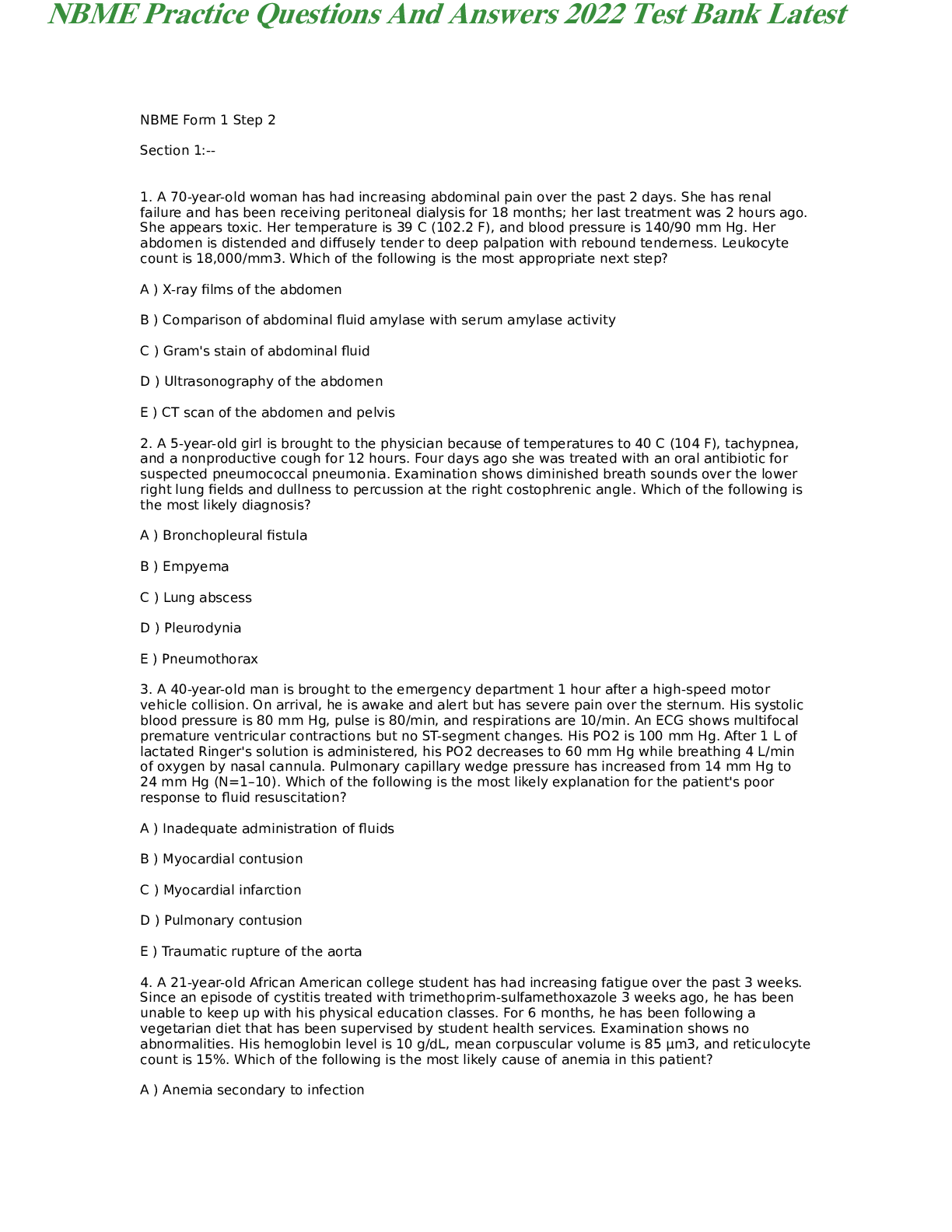

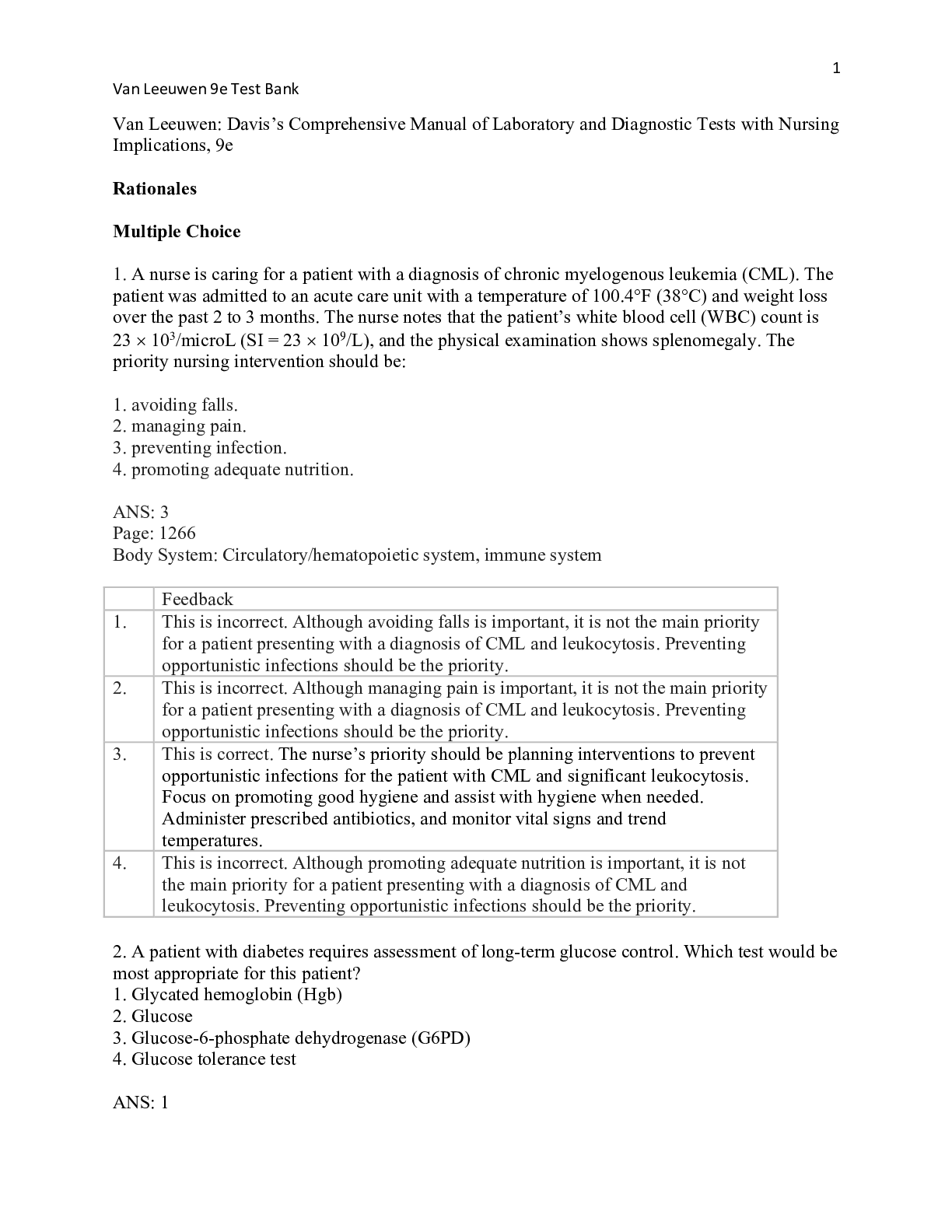
.png)
.png)


.png)
 Susan Whitbourne, Stacey Whitbourne, Candace Konnert (Test Bank).png)



